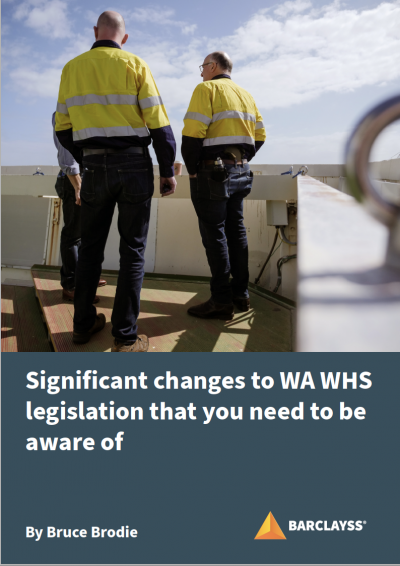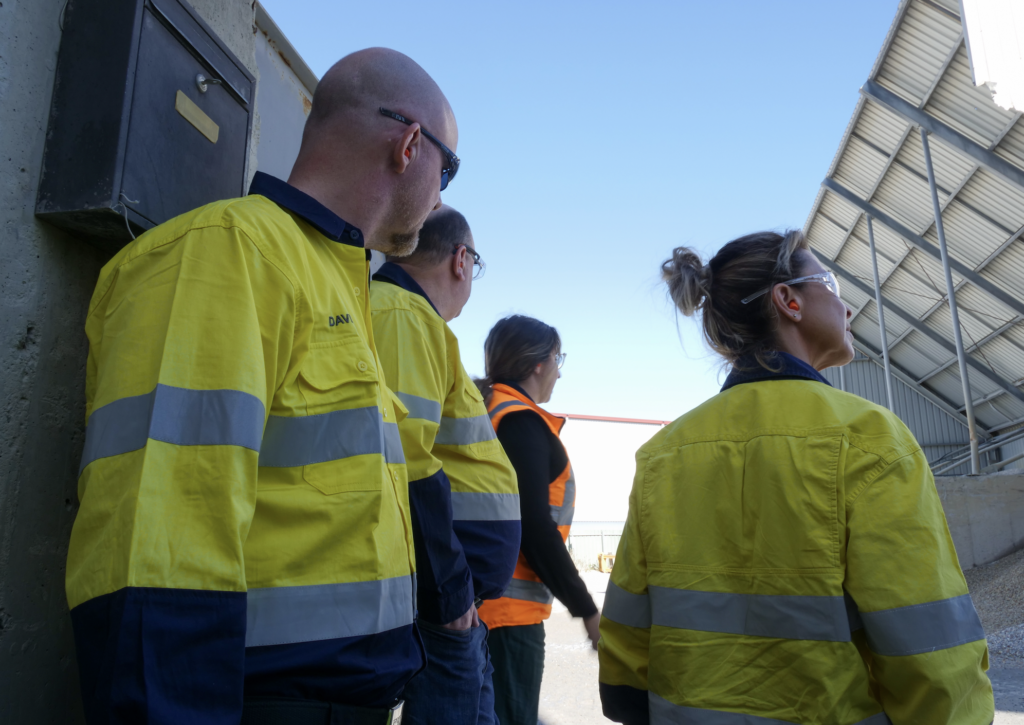“There have been some significant changes to the WA WHS legislation that will require a ‘considered’ approach by businesses in order to remain compliant with the new legislation.”
YOUR GUIDE
Barclayss® HS-Consultant Advisor, Bruce Brodie is helping businesses understand the changes to the WA WHS Legislation which came into operation on the 31st of March 2022.
There are four significant changes:
1. New health and safety duty holders – ‘PCBU and Officer’
2.New term – ‘so far as reasonably practicable’.
3.New definition of health – now includes ‘psychological health’
4.New intent of ‘health and safety communication’
For an in-depth exploration of these points, download Bruce’s free guide below.

Gap Analysis
With the new WA WHS legislation now in force, several of our clients have requested a gap analysis of their H&S management system be conducted to determine compliance with the new legislation.
This analysis has not only identified the gaps in their management system but also provided a working plan on how to address these gaps.
Contact us below for more information.

BOOK A FREE CONSULTATION
CALL US
Frequently Asked Questions
What are my responsibilities in relation to workplace health and safety (WHS) legislation?
As an employer you are required to provide and maintain a safe place of work, where so far as is practical, your employees are not exposed to hazards. Additional responsibilities include providing employees with instruction, information, training and supervision, a method for consultation on WHS issues and measures to provide protection where exposure to hazards is not preventable.
In practice, it is often the way WHS responsibilities are carried out within a business that have the greatest impact on its WHS performance. This is a key area where Barclayss® can help you and your team.
What WHS legislation applies in WA?
WA Work Health and Safety Act 2020 applies to all Western Australian workplaces, including mines, petroleum and geothermal energy operations. The Act came into force on the 10th November 2020.
Which WHS legislation do most states work within?
All Australian states and territories (except Victoria) have WHS legislation largely based on the national model WHS Act. This allows for companies operating nationally to have similar obligations and requirements across all locations.
When was the WA WHS Act introduced?
The WA WHS Act came into force on the 10th November 2020.
Are WHS regulations legally binding?
WHS Regulations are legally binding. Breaches of regulations can result in penalties.
How do I get started on building a safety management system?
The first stage is to decide whether you need to, or want to achieve a particular HS standard. This provides a guide for defining the structure of your HS Management System. Even if it isn’t your main priority, it’s a good idea to follow this route, as if you decide to target achievement of a standard in the future, your Management System will be restructured in an appropriate way.
The next stage is to conduct a gap analysis of your current system/documentation against the selected structure to highlight the areas that are absent or need work to bring them up to the required level. Then the work begins….. creating new documentation and updating or improving current documentation to ensure that it provides the required level of information for the system users.
The final stage is to implement the system, through a coordinated roll-out process. This stage will involve training leaders and employees in the key responsibilities and actions that they need to do to comply with the system.
Sounds easy! It can be, but it also can be resource intensive and technically complicated, and these are areas where Barclayss® can help you get started.
How do I become ISO accredited?
The route to certification starts with a conversation with an accreditation provider. The provider will share the expectations and requirements needed to gain certification. They will also confirm the process that you need to follow.
The next step us typically a gap analysis audit that reviews your system against the relevant standard and highlights areas for improvement prior to the formal certification audit.
The certification audit will assess your level of compliance against both the standard and your own system requirements and highlight any areas of non-conformance. If minimal non-conformances are identified, you can be granted your accreditation shortly after this audit. However, this is not usual, as most audits identify a mixture of major and/or minor non-conformances that require work to fix them. Once resolved, the provider will return to assess the non-conformances and confirm whether they can be closed out. Once closed out, the provider can recommend to the certification body that your organisation receives its certification.
Again, this is a resource intensive and technically complicated process and Barclayss® can help you with managing your journey to certification.
How do I ensure compliance to the new workplace health and safety (WHS) legislation?
The new WHS legislation is expected to be enacted in WA from January 2022.
Within the legislation, if WHS duties are new, or have changed substantially from the current arrangements, there will be a transition period for WA businesses to adopt the new requirements. During this transition period, businesses will have time to assess the implication of the new arrangements on their current operation and work out what changes they need to complete to achieve compliance. Barclayss® can assist you in identifying the required changes, developing any new/modified systems, work methodologies and/or operating practices and implementing them in your workplace.
Where the new arrangements are identical/very similar to the current requirements, it is anticipated (although not guaranteed) that the established processes within a business will ensure compliance, when the legislation is in place.
However, it’s recommended that businesses conduct a review of their existing HS Management System against the requirements of the new legislation, even where it appears that the legislation hasn’t changed significantly, to identify where there may be gaps and the need for improvement. Barclayss® can help you with completing these reviews and tackling any improvement areas that they reveal.



